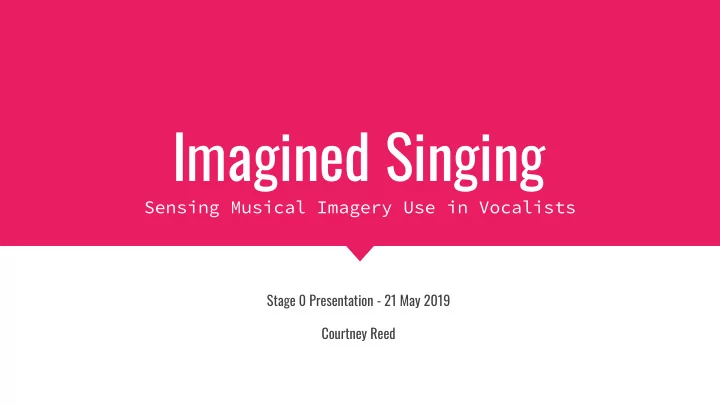

Imagined Singing Sensing Musical Imagery Use in Vocalists Stage 0 Presentation - 21 May 2019 Courtney Reed
Presentation Structure ➢ Introduction ➢ Background and Related Work ➢ Research Questions ➢ Proposed Studies ➢ PhD Timeline
Introduction Musical imagery = anticipation of action Abstract intention → Concrete execution What are the channels that Can we measure, via the body, link thought to action? what occurs within the mind? Focus on the voice as an instrument that exists solely within the body - requires extensive use of metaphor
Musical Imagery Anticipating the outcome through sensory visualisation [3,10] Imagining an action and actually doing it → These share the same neural pathways [7] Focus on how something feels, looks, and sounds in performance in order to recreate it “Imagery toolboxes” are built [15] during practice and rehearsal, and called up during performance [14] Metaphors as abstract representations of techniques
Audiation Subvocalisation = the voice in your head “Talking to yourself” Audiation = when vocalists sing to themselves Reading through a new piece of music ➢ Mental rehearsal ➢ Keeping a tonal center or tempo ➢
Gesture in Performance Leman & Godøy [4] - The musical experience as “inseparable from the sensations of movement” effective gestures: generate sound accompanist gestures: facilitate sound production figurative gestures: interpretation and expression Gestures work with imagery to help with anticipation Feel the timing in the body [11] , prepare for the sound production, express emotional content
Voice Physiology Respiratory Muscles [2,5] Vocal Tract [8] Abdominal and neck/shoulder regions Diaphragm and intercostals Laryngeal movements maintain P s Cricothyroid tension Maintain “supported breathing”
Measuring Subvocalisation Media Lab (MIT) Kapur et al. AlterEgo [9] “inner voice” during subvocalisation Readings of nerve impulses across facial and laryngeal muscle articulators Trained a model to group movements for word patterns and hear “inner voice”
How do vocalists use imagery 1 (including metaphor) and gesture? Research How can we accurately measure 2 muscular activity during Questions audiation, as done with speech? 3 How does physiology change with different intention? 4 How can we detect expressive intent in muscular activations?
Hypotheses Vocalists actively use audiation to adapt to non-ideal performance situations and depend on imagined sound to include expression in their performances. There is a connection between visualised sound during audiation and physical execution, which is observable at the muscular level. These muscular activations reflect the performance intentions and use of imagery.
Proposed Studies Study 1 Study 2 Study 3 Vocalists perform A network of sensors Muscular activations against altered is developed and during audiation are auditory feedback, tested for the used to train a using audiation to accurate detection model which can maintain accuracy of low-level identify a vocalist’s and achieve muscular movement intended sound and expressive goals. during audiation. its quality.
Methodology and Analysis Mixed methods for data analysis: Quantitative - Performance analyses [6,12-13] Tracked muscular activation and nerve impulses [9] Thematic Analysis [1] of imagery Qualitative - Perceptual Testing [14]
Initial Study Audiation in vocal Subvocalisation tasks: - “sing to yourself” for specified time performance - undefined silence or cued entrances Altered auditory feedback tasks: Observe the use of - sing with delay or reverb - sing with pitch shifting musical imagery when vocalists perform Reflection tasks: - rank difficulty of conditions under non-ideal Instruction tasks: conditions - gather insight about imagery language
PhD Timeline
Bibliography [1] V. Braun and V. Clarke. “Thematic Analysis.” In: PA Handbook of [9] A. Kapur, S. Kapur, and P. Maes. “AlterEgo: A Personalized Research Methods in Psychology. Ed. by H. Cooper, P. M Camic, D. Wearable Silent Speech Interface.” In: Proceedings of the 2018 L. Long, A. T. Panter, D. Rindskopf, and K. J. Sher. Vol. 2: Conference on Human Information Interaction & Retrieval (IUI Research Designs: Quantitative, Qualitative, Neuropsychological, ’18), Tokyo, Japan. Mar 7-11, 2018, pp. 43–53. and Biological. Washington: American Psychological Association, [10] P. E. Keller. “Mental imagery in music performance: underlying 2012. mechanisms and potential benefits.” In: Annals of the New York [2] A. Bouhuys, D. F. Proctor, and F. Mead. “Kinetic aspects of Academy of Sciences 1252.1 (2012), pp. 206–213. singing.” In: Journal of Applied Physiology 21.2 (1966), pp. [11] P. E. Keller and M. Appel. “Individual Differences, Auditory 483–496. Imagery, and the Coordination of Body Movements and Sounds in [3] R. I. Godøy and H. Jørgensen. Musical Imagery. Studies on New Musical Ensembles.” In: Music Perception 28.1 (2010), pp. 27–46. Music Research 5. Lisse, Netherlands: Swets & Zeitlinger, 2001. [12] K. Kosta, R. Ramirez, O. Bandtlow, and E. Chew. “Mapping between [4] R. I. Godøy and M. Leman. Musical Gestures: Sound, Movement, and dynamic markings and performed loudness: A machine learning Meaning. New York: Routledge, 2010. approach.” In: Special Issue on Music and Machine Learning, [5] B. Griffin, P. Woo, R. Colton, J. Casper, and D. Brewer. Journal of Mathematics and Music 10.2 (2016), pp. 149–172. “Physiological characteristics of the supported singing voice: A [13] K. Kosta, R. Killick, O. Bandtlow, and E. Chew. “Dynamic Change preliminary study.” In: Journal of Voice 9.1 (1995), pp. 45–56. Points in Music Audio Capture Dynamic Markings in Score.” In: A. [6] P. Grosche, M. Müller, and F. Kurth. “Cyclic Tempogram – A Volk, T. Collins, D. Meredith, eds., Late Breaking/Demo Session, Mid-Level Tempo Presentation for Music Signals.” In: Proceedings International Conference on Music Information Retrieval of IEEE International Conference on Acoustics, Speech and Signal (ISMIR’17), Suzhou, China. Oct 23-28, 2017. Processing, Dallas, TX, USA. Mar 14-19, 2010. [14] B. H. Repp. “Effects of auditory feedback deprivation on [7] A. R. Halpern and R. J. Zatorre. “When that tune runs through expressive piano performance.” In: Music Perception 16.4 (1999), your head: A PET investigation of auditory imagery for familiar pp. 409–438. melodies.” In: Cerebral Cortex 9 (1999), pp. 697–704. [15] W. H. Trusheim. “Audiation and Mental Imagery: Implications for [8] W. J. Hardcastle. Physiology of Speech Production: An Artistic Performance.” In: The Quarterly 2.1-2 (2010), pp. Intro for Speech Scientists. London: Academic Press Inc., 1976. 138–147.
Recommend
More recommend